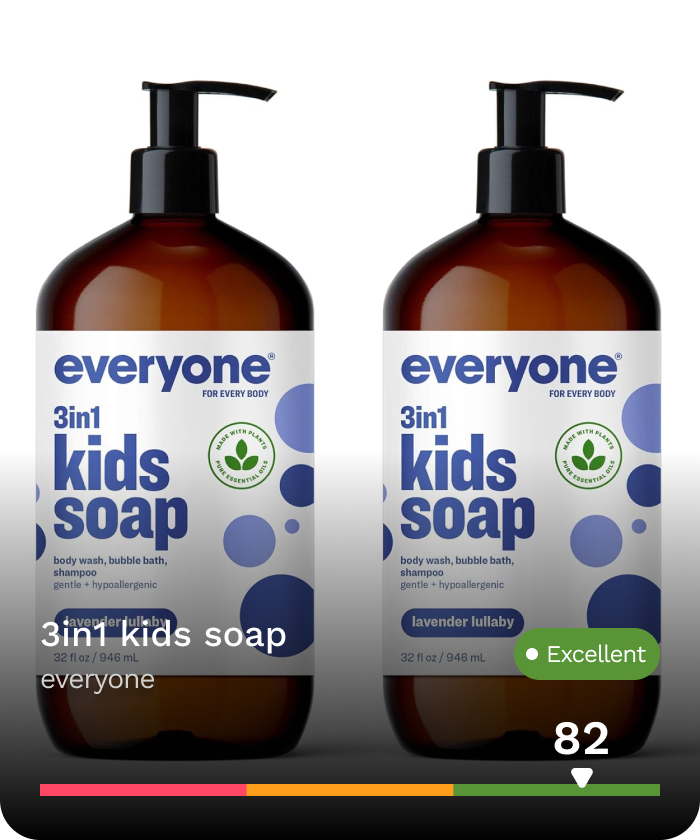TL;DR
Avoiding Harmful Chemicals in Baby Skin Care Products
Babies are especially vulnerable to harmful chemicals in skin care products due to their delicate skin and developing immune systems. Carcinogens like 1,4-dioxane and BPA in products such as bubble baths and baby bottles are linked to cancer and developmental issues. Other harmful substances include synthetic fragrances, sulfates, and chlorine bleach, which can cause skin irritation, dryness, and respiratory problems. Opt for non-toxic, safe alternatives to ensure your baby’s health and well-being.
Common Harmful Chemicals in Baby Skin Care Products
- 1,4-Dioxane: A solvent found in cosmetics, detergents, and shampoos, it is classified as a possible carcinogen (IARC 2B) and linked to eye, nose, and throat irritation, as well as liver and kidney damage. Infants may face higher vulnerability, emphasizing the need for regulation.
- BPA: Commonly used to harden plastics, BPA can leach into food and drinks, especially when heated. Linked to hormonal disruptions and developmental issues, it has been banned in baby bottles since 2012 due to its estrogen-mimicking effects and potential long-term health impacts.
Health Risks and Skin Conditions from Baby Products
- Carcinogens: Chemicals like 1,4-dioxane and BPA are linked to cancer and developmental disorders.
- Endocrine Disruptors: Phthalates and parabens interfere with hormone systems, leading to early puberty and potential developmental issues.
- Skin Irritants: Fragrances, formaldehyde, bronopol, and quaternium-15 can cause rashes, eczema, and dermatitis.
- Dryness & Irritation: SLS and SLES strip natural oils, while nanoparticles and synthetic fragrances can harm respiratory health.
Identifying Harmful Ingredients in Baby Skincare Products
- Common Harmful Chemicals: 1,4-dioxane, BPA, parabens, phthalates, bleach, sulfates, and synthetic fragrances can cause cancer, skin irritation, and other health issues.
- Misleading Labels: Even products labeled as “natural” or “gentle” may contain these harmful ingredients.
- How to Stay Safe: Read ingredient lists carefully, consult a pediatrician for recommendations, and choose vetted natural alternatives to protect your baby’s sensitive skin.
Potential Health Risks from Baby Skincare Products
- Common Skin Conditions: Chemicals in baby skincare products can trigger eczema (dry, itchy rashes), hives (swelling caused by allergens), allergic contact dermatitis (rashes from allergens), and angioedema (deep tissue swelling around the eyes or mouth).
- Vulnerable Infants: Babies with a family history of allergies or asthma are at a higher risk of skin conditions.
- Prevention and Care: Parents should watch for signs like rashes or swelling, opt for gentle, allergen-free products, and maintain a consistent skincare routine to reduce flare-ups and protect their child’s sensitive skin.
Introduction
Ensuring the safety of your baby is paramount, especially when it comes to selecting
skin care products. Unfortunately, many baby products on the market contain harsh
toxins and chemicals that can pose significant risks to your child's health. Babies are
particularly vulnerable to these substances due to their developing immune systems
and delicate skin[1][3].
Carcinogens, which are substances capable of causing cancer, are more harmful to
children than adults. Studies have shown that the average carcinogen is ten times
more potent for children and can be up to sixty-five times more toxic when causing
cancer through genetic abnormalities[2]. Some of the harmful chemicals found in
baby skin care products include 1,4-dioxane, which is often a contaminant in bubble
baths and body washes and is linked to cancer, and Bisphenol A (BPA), commonly
found in baby bottles and food containers, which has been associated with increased
cancer risk, early puberty, and developmental disorders[4].
Other concerning chemicals include synthetic fragrances, which can cause allergic
reactions and skin irritation, and sulfates, which can lead to dryness and rashes.
Additionally, chlorine bleach, used in various cleaning products, is a lung, skin, and
eye irritant and has been linked to asthma[5][6].
Given these risks, it is crucial to opt for non-toxic and safer alternatives to protect your
baby's health and well-being[1][3].

ALVA Veriefied products
When you make a purchase through retailer links on our site, we may earn commission through affiliate programs. All affiliate fees ALVA receives support our mission. Learn more here
Are your products safe?
Scan your products now with the ALVA app to get a personalised risk analysis.
Common Harmful Chemicals in Baby Skin Care Products
1,4-Dioxane
1,4-Dioxane is a cyclic ether used primarily as a solvent in the manufacture of other
chemicals and as a stabilizer for chlorinated solvents such as 1,1,1-trichloroethane-
[17]. It has also been identified as a contaminant in various consumer products,
including cosmetics, detergents, and shampoos[17]. This widespread use has led to
significant environmental release and groundwater contamination.
At room temperature, 1,4-dioxane is a colorless liquid with an ether-like odor and is
highly ignitable when exposed to heat, sparks, or flames[16]. It is miscible with water,
which facilitates its dispersion in the environment and potential human exposure[16].
Exposure to high amounts of 1,4-dioxane can result in eye, nose, and throat irritation,
as well as liver and kidney lesions[16]. However, there is no conclusive data to
suggest that children are more susceptible to its toxicity compared to adults[16].
Importantly, 1,4-dioxane has been classified as a class 2B carcinogen by the Interna-
tional Agency for Research on Cancer (IARC), indicating it is possibly carcinogenic
to humans[17]. The United States Environmental Protection Agency (US-EPA) also
considers it a likely human carcinogen[17]. This classification underscores the need
for careful regulation and monitoring of 1,4-dioxane levels in consumer products,
especially those used by infants, who might be more vulnerable to toxic effects.
BPA
Bisphenol A (BPA) is a chemical compound that was first synthesized in 1891 by
the Russian chemist Aleksandr Dianin[12]. It is widely used to harden plastics and
is found in numerous products, including sports equipment, water bottles, medical
devices, and as a coating in food and beverage cans[13][14]. The Centers for Disease
Control and Prevention have detected measurable levels of BPA in more than 90%
of the U.S. population, with infants and children showing the highest estimated daily
intakes[14].
The health risks of BPA have garnered significant attention, especially concerning
its effects on infant development. BPA can leach out of plastics more readily when
exposed to higher temperatures, such as when warming baby bottles, leading to
higher exposure levels in infants[14]. This has led to the Food and Drug Administration
(FDA) banning the use of BPA in baby bottles in 2012, a move that followed voluntary
removals by several large manufacturers[14].
Research indicates that BPA exposure can have complex developmental effects. The
compound is known to act as an estrogen agonist, and early experiments demon-
strated its ability to mimic estrogen in ovariectomized, estrogen-deficient rats[12].
This is particularly concerning for infants, as hormonal disruptions during critical
periods of development can lead to long-term health issues. Epidemiological studies
have reported adverse behavioral outcomes in children exposed to BPA, though
the exact mechanisms and corresponding effects on brain structure are still under
investigation[15]. These findings highlight the need for careful consideration of BPA
exposure, especially in products intended for infants and children.
Health Risks and Potential Skin Conditions
The delicate nature of a baby’s skin makes it particularly susceptible to the adverse
effects of harmful chemicals commonly found in many skincare products. Certain
chemicals in baby lotions and creams are known to cause various health issues and
skin conditions.
One of the most alarming categories of chemicals is carcinogens. For instance,
1,4-dioxane, a byproduct often found in products containing sodium laureth sulfate,
is linked to cancer[7][9]. Similarly, Bisphenol A (BPA), frequently used in baby bottles
and other containers, is associated with an increased risk of cancer and develop-
mental disorders[9][18].
Endocrine disruptors, which interfere with the body’s hormone system, pose another
significant risk. These chemicals, such as phthalates and parabens, can be partic-
ularly harmful to infants as their bodies are still developing. Phthalates are linked to
early puberty and developmental issues, while parabens have been found in breast
cancer tissues[9][18][11].
Skin irritation and allergic reactions are also common outcomes of exposure to
certain chemicals in baby skincare products. For example, fragrances, despite mak-
ing lotions smell pleasant, are notorious for causing allergies, skin irritation, and
eczema[19]. Formaldehyde, another common ingredient, can lead to skin rashes and
is also a recognized carcinogen[18].
Additionally, preservatives like bronopol and quaternium-15, which release formalde-
hyde, can cause both immediate and long-term skin issues. These chemicals can
lead to dermatitis and other skin sensitivities[7][18].
Other harmful substances, such as sodium lauryl sulfate (SLS) and sodium laureth
sulfate (SLES), used as foaming agents, are known to strip the skin of its natural
oils, causing dryness and irritation[7][18]. Furthermore, nanoparticles and synthetic
fragrances have been linked to respiratory issues and are especially dangerous for
infants with developing respiratory systems[7][11].
Given these potential health risks, it is crucial for parents to be vigilant and selective
about the products they use on their babies. Opting for products free from these
harmful chemicals can help safeguard infants’ health and well-being[7][19][20].
Identifying Harmful Ingredients on Labels
Understanding which baby skincare products to buy can be challenging due to the
plethora of ingredients that can potentially harm your child’s sensitive skin. It is
essential to be aware of these ingredients and know how to read product labels
effectively[32]. Some of the harmful chemicals commonly found in baby skincare pro-
ducts include 1,4-dioxane, BPA, parabens, and phthalates[29][30]. These substances
can cause a range of health issues, including cancer, skin irritation, and genetic
abnormalities, with children being significantly more susceptible than adults[30][33].
Parents can identify harmful chemicals by carefully examining the ingredient list on
the product labels. Ingredients such as bleach, sulfates, and synthetic fragrances
are often present in products labeled as “natural” or “gentle,” despite their potential
dangers[33]. For instance, bleach is corrosive and can cause severe irritation and
tissue damage, while sulfates can lead to skin and scalp irritation[33].
To ensure the safety of baby skincare products, it is also beneficial to consult with
a pediatrician about an appropriate skincare routine during your baby’s first check-
ups[32]. Opting for products that are free from these harmful chemicals can prevent
adverse health effects and keep your baby’s skin healthy and moisturized[34]. In
addition, choosing natural alternatives vetted for safety and efficacy can be a reliable
way to protect your little one’s delicate skin[31].
Potential Health Risks
The potential health risks associated with chemicals present in baby skin care
products are a significant concern for many parents. Skin allergies in babies can
be triggered by various factors, including reactions to certain chemicals in these
products[23]. Common skin conditions that may arise from exposure to irritating
substances include eczema, hives, and allergic contact dermatitis[23][26].
Eczema, or atopic dermatitis, is a prevalent skin allergy that causes rashes and
itching in babies[24][25]. It often manifests as patches of dry, flaky, and rashy skin,
particularly on the face and in skin folds around the knees, wrists, and elbows[24][28].
This condition is more common in infants with a family history of allergies, eczema, or
asthma and affects a significant percentage of children in the United States[24][26].
Regular and gentle skincare is essential to manage eczema, prolong the periods
between flare-ups, and reduce their severity[24].
Hives, also known as urticaria, are skin swellings that can occur anywhere on the
body[23]. These can be triggered by various allergens, including certain chemicals
in skin care products. Additionally, insect bites may cause papular urticaria, which
appears as itchy, wheal-like papules[23].
Allergic contact dermatitis is another concern, which occurs when the skin reacts to
direct contact with an allergen[23][26]. This can result in a rash that usually clears up
once the irritating substance is removed from contact with the skin[26].
Furthermore, angioedema, characterized by swelling of deep skin tissues, often
around the eyes or mouth, can also be a reaction to allergens in baby skin care
products[23]. This condition can be particularly distressing for both infants and their
parents.
Parents need to be vigilant about the signs and symptoms of skin irritation, such
as dry, flaky patches, rashes, and areas of swelling, as these can indicate adverse
reactions to skincare products[24][25]. Proper care and cautious selection of baby
skin care products can help mitigate these potential health risks and ensure the
well-being of their children.
Regulatory Standards and Gaps
Regulatory standards for baby skincare products are crucial to ensuring the safety
and health of infants, whose delicate skin requires gentle care. In the United States,
the Food and Drug Administration (FDA) plays a significant role in regulating these
products. The FDA enforces various laws and regulations, including the Federal Food,
Drug, and Cosmetic Act, the Modernization of Cosmetics Regulation Act of 2022, the
Fair Packaging and Labeling Act, and the Microbead-Free Waters Act of 2015[39].
These regulations ensure that skincare products for babies meet safety, efficacy, and
labeling standards[40].
Despite these federal regulations, significant gaps remain in the regulatory frame-
work. One major issue is that the responsibility for ensuring compliance with safety
standards often falls on the manufacturers themselves, who are expected to self-reg-
ulate, self-test, and self-report their products’ safety and compliance. This self-reg-
ulation creates opportunities for unscrupulous manufacturers to bypass the safety
standards, potentially leading to the availability of unsafe products on the market[35].
Another gap is the inconsistency in regulatory oversight across different jurisdictions.
For example, while the FDA regulates cosmetics at the federal level, some states
have adopted additional legislation to address specific safety concerns. Minnesota,
for instance, banned the use of formaldehyde and formaldehyde-releasing preserva-
tives in children’s personal care products in 2013[41]. This state-level intervention
indicates that federal regulations may not be comprehensive enough to cover all
harmful chemicals.
Furthermore, the current regulations may not fully address the unique needs of
infants’ skin, which is thinner and more sensitive than adult skin[38]. Parents are
increasingly vigilant, scrutinizing product labels to ensure they select the safest
options for their children[36]. This heightened awareness underscores the need for
more stringent and specific regulations that address the particular vulnerabilities of
babies’ skin.
To address these gaps and ensure better protection for infants, it is essential to
enhance federal oversight and reduce the reliance on manufacturer self-regulation.
Implementing stricter testing and compliance protocols, increasing transparency in
labeling, and harmonizing regulations across states can help close the existing
regulatory gaps. By doing so, we can better safeguard the health and safety of infants
who rely on these products.
REFERENCES:
[1]: 29 Ingredients to Avoid in Baby Products | Puracy
[2]: 20 Harmful Chemicals You Must Avoid In Baby Skincare Products
[3]: 7 Chemical Ingredients In Baby Products That You MUST Avoid – BabyChakra
[4]: Toxic Chemicals Commonly Found in Baby Products – Women’s Voices for …
[5]: Non Toxic Baby Products: 10 Ingredients and Chemicals To Avoid
[6]: Non-Toxic Baby Products: 10 Ingredients To Avoid
[7]: 29 Ingredients to Avoid in Baby Products | Puracy
[8]: 20 Harmful Chemicals You Must Avoid In Baby Skincare Products
[9]: Toxic Chemicals Commonly Found in Baby Products – Women’s Voices for …
[10]: 7 Chemical Ingredients In Baby Products That You MUST Avoid – BabyChakra
[11]: Avoiding harmful chemicals in baby products: advice for parents
[12]: The Effects of Bisphenol A on Embryonic Development
[13]: The Facts About Bisphenol A, BPA – WebMD
[14]: Are Bisphenol A (BPA) Plastic Products Safe for Infants and Children?
[15]: Prenatal maternal and childhood bisphenol a exposure and brain …
[16]: Medical Management Guidelines for 1,4-Dioxane – Centers for Disease …
[17]: EHS Conferences – 1,4-Dioxane | Yale School of Public Health
[18]: 29 Ingredients to Avoid in Baby Products – Puracy
[19]: 5 toxic chemicals you should avoid in baby care products
[20]: The 14 Toxic Cosmetic Ingredients to Avoid (and How to Find Healthier …
[21]: Baby Lotions: What ingredients Consumer Reports says to avoid …
[22]: Baby lotion ingredients investigated by Consumer Reports – 9news.com
[23]: 5 Types Of Skin Allergies In Babies, Treatment & Prevention – MomJunction
[24]: Baby Eczema – Symptoms, Causes, and Treatment | Eucerin
[25]: 5 Common Baby Skin Care Issues and What to Do About Them – Parents
[26]: Baby Eczema (Atopic Dermatitis) on Your Infant: Symptoms & Treatment
[27]: Baby Skin Allergies: Causes & Care Tips | SuperBottoms
[28]: Newborn eczema | nappy rash | sensitive skin irritation in babies …
[29]: 29 Ingredients to Avoid in Baby Products – Puracy
[30]: 20 Harmful Chemicals You Must Avoid In Baby Skincare Products
[31]: 14 Safest Non-Toxic Baby Lotions from Natural & Clean Brands
[32]: Choosing Safe Ingredients in Baby Skin Care Products – Healthline
[33]: 20 Ingredients to avoid in Children Skin and Hair Products
[34]: 7 Chemical Ingredients In Baby Products That You MUST Avoid – BabyChakra
[35]: Help! Is This Thing Safe? Demystifying Baby Product Safety Regulations …
[36]: Understanding FDA Regulations: A Guide for Baby Skincare Manufacturers
[37]: Regulatory Compliance and Safety Standards Assessment
[38]: Baby Care: What Does the Regulation Say? – Typology Paris
[39]: Cosmetics Laws & Regulations | FDA
[40]: Cosmetics Guidance & Regulation | FDA – U.S. Food and Drug Administration
[41]: Laws & Regulations on Chemicals in Cosmetics | Safe Cosmetics
Are your products save?
Download ALVA to check if the products you use regularly are free from dangerous chemicals.

